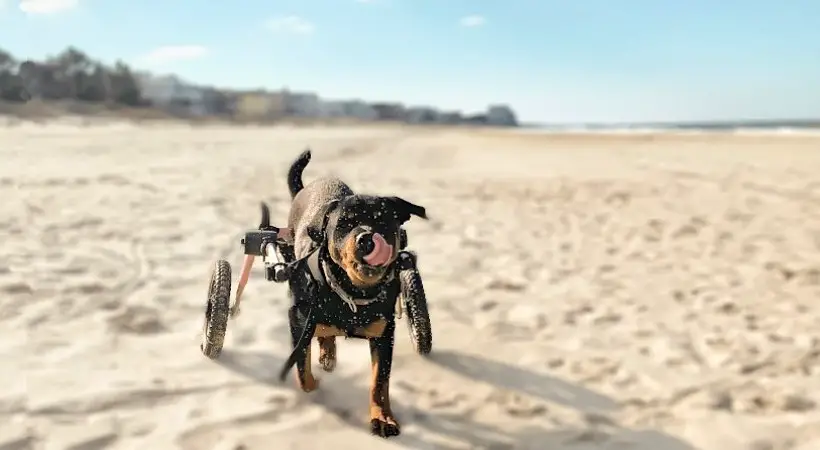We expect our senior dogs to slow down as they age, but it can also mean that our dog may be struggling with changing mobility. There are five common causes of Rottweiler mobility problems, hip dysplasia, elbow dysplasia, CCL tears, IVDD, and heart problems.
Dysplasia in Rottweilers
As a large breed dog, the Rottweiler is at high risk for joint conditions such as dysplasia. Dysplasia can impact the front legs in the elbow joint or the hip joint in the back legs. Dogs with dysplasia can experience painful and swollen joints that make it difficult for them to go for a walk.
Hip Dysplasia
Hip Dysplasia is a progressive joint condition that worsens from the wear and tear on a dog’s hips. The earliest signs of Hip Dysplasia are likely to go unnoticed by most pet parents but will be easily noticed during your Rottweiler’s annual vet checkups.
A Rottweiler with hip dysplasia may limp while walking or bunny hop, a term used to describe when a dog moves their two hind legs at the same time. Mild hip dysplasia symptoms may infrequently occur. Whereas in more severe dysplasia, daily exercise may be challenging, and the Rottie may be unable to place weight on their hind legs.
There are some simple ways to help your Rottweiler to deal with their hip dysplasia pain:
- Keep your Rottweiler at a healthy weight to lessen the pressure on their back legs
- Daily joint supplements can promote canine hip health
- Provide hip support to relieve hip pain and support the joint
- Severe hip dysplasia may require a dog wheelchair to promote continued exercise
Elbow Dysplasia
Elbow Dysplasia impacts over a third of all Rottweilers and is one of the most common causes of front limb lameness in dogs. Signs of Elbow Dysplasia are noticeable when the dog is very young, usually under the age of 6 months.
Elbow Dysplasia is a genetic condition that a dog is born with. It is not a condition that develops due to an injury. As the dog ages, the malformation of the elbow joint will worsen, and arthritis symptoms will become more apparent and require lifelong care.
A Rottweiler with elbow dysplasia will exhibit joint pain anytime their front leg is bent or straightened. Pushing up off the ground can be very difficult for the pet. Limping and joint pain may worsen with exercise, depending on the severity of the dysplasia.
Help your Rottweiler with elbow dysplasia:
- Weight management and joint supplements to keep the joint healthy
- A custom elbow brace can support the elbow joint
IVDD
Although Intervertebral Disc Disease is most often associated with dachshunds and corgis, IVDD can also occur in large breed dogs. Type 2 IVDD is the most common form of Intervertebral Disc Disease in large dogs, like a Rottweiler. The second type of IVDD typically progresses slowly with spinal cord compression. Most often, the disc rupture occurs in the center of the back, although less than 20% occurs in the neck.
The signs of IVDD typically include sudden loss of back leg function or leg weakness. IVDD dogs with rear leg weakness may limp as they walk or favor one leg over the other. A Rottweiler who cannot stand or walk without assistance needs to be examined by their veterinarian. The sooner a dog can be diagnosed and treated for IVDD, the better prognosis.
Cranial Cruciate Ligament Rupture
Rottweilers are predisposed to CCL tears and knee injuries. Although there is no proven genetic link between the breed and its risk for CCL ruptures, the Rottweiler is the most likely breed to rupture its cruciate ligament.
When a dog’s cruciate tears, it can occur slowly over time or very suddenly. Although it may be difficult to prevent the tear, you need to be aware of your dog’s knees and check them regularly to catch any early signs of issues. Common symptoms of dog knee issues include clicking sounds when walking, limping, or leg stiffness (especially after exercising).
Aortic Stenosis
Aortic Stenosis is a canine heart condition where the blood flow is partially blocked as it leaves the left ventricle through the aorta. Due to the obstruction, the Rottweiler’s blood can’t flow easily to the rest of the body, so the heart pumps harder to push blood through the opening.
Although Aortic Stenosis is not a mobility condition, it can cause fainting, panting, and an intolerance to exercise. Rottweilers with Aortic Stenosis will be on restricted exercise and need to avoid anything too strenuous to limit the stress on their heart. Canine heart failure can occur in dogs with Aortic Stenosis. Therefore, it’s imperative that a veterinarian see any dog with a heart condition or canine cardiac specialist for proper diagnosis and treatment.
Conclusion
The average lifespan for a Rottweiler is between 8-10 years. With a better understanding of the signs of mobility loss, you will know how to care for your senior Rottweiler. Knowing by the signs and symptoms of joint pain, heart issues, and changing mobility, you can help your Rottie get the care it needs to enjoy every minute and stay active!
